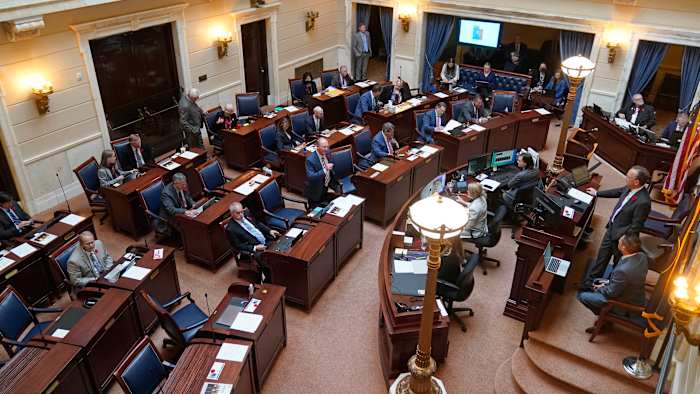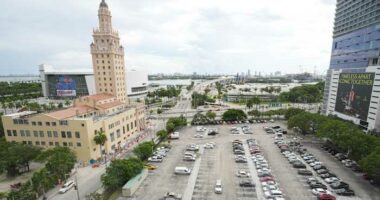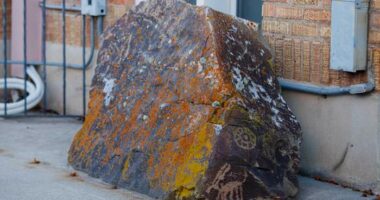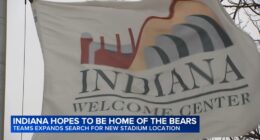Share this @internewscast.com

SALT LAKE CITY – Utah finds itself embroiled in a national dispute over redistricting due to a court mandate to revise its congressional map for the 2026 midterm elections. Meanwhile, President Donald Trump is urging other Republican-governed states to gain additional U.S. House seats for the GOP.
The revised district lines could potentially make one of Utah’s four congressional seats a viable target for Democrats, as the party endeavors to overturn the GOP’s narrow House majority. On a national level, Democrats must gain three seats next year to secure control of the chamber.
The current configuration divides the densely populated Salt Lake County—an enclave of Democratic support within a predominantly red state—across all four congressional districts. Prior to the map’s adoption in 2021, one district alternated between Democrat and Republican control. Since then, Republicans have won in all districts by significant margins.
Here’s what to know about Utah’s place in the redistricting fight.
Judge says the current map defies voters
On Monday, a judge directed the Republican-led Utah Legislature to discard its congressional map and swiftly establish a new one. District Court Judge Dianna Gibson deemed the map illegal on the grounds that the Legislature bypassed an independent redistricting commission, set up by voters to prevent deliberate partisan advantage, commonly known as gerrymandering.
In 2018, voters narrowly endorsed a ballot initiative that formed the commission to delineate boundaries for Utah’s legislative and congressional districts, which the Legislature was obligated to consider. However, lawmakers repealed the initiative in 2020, replacing it with legislation that converted the commission into an advisory body that could be ignored. Subsequently, lawmakers disregarded a congressional map suggestion from the commission and devised their version.
The Utah Supreme Court indicated that the Legislature has very limited authority to modify laws passed by voters and remanded the case to Judge Gibson to resolve the map’s status.
“How district lines are drawn can either safeguard representation and ensure accountability by elected representatives or erode public trust, silence voices and weaken the rule of law,” she wrote in the ruling.
Gibson has given lawmakers until Sept. 24 to adopt a map that complies with voter-approved standards. Voting rights advocates who were involved in the legal challenge can submit alternate proposals. But Republican officials could use appeals to try to run out the clock before a candidate filing deadline in early January to possibly delay adopting new maps until 2028.
The U.S. Supreme Court is unlikely to intervene, and the state Supreme Court may be hesitant to entertain an appeal after it already asked Gibson to decide.
New district lines mean new matchups
Utah’s four congressional districts currently converge within a couple blocks in the Salt Lake City suburb of Millcreek. A voter could grab a milkshake at the beloved Iceberg Drive Inn and cross into all four districts before it melts.
Lawmakers presented the map as a way for each representative to serve both urban and rural areas. One district spans the entire eastern border of the state and groups vastly different communities, from the winter resort town of Park City, to the urban center of Provo, down to the red rock recreation hub of Moab. Voting rights groups who challenged the map argued it intentionally dilutes the Democratic vote and produces congresspeople who aren’t suited to represent all of their constituents.
The tight deadline for lawmakers to draw new maps could push them to reconsider proposals from the independent redistricting commission that they had ignored after the 2020 census. Those plans create a compact district combining the Democrat-heavy cities of Salt Lake City and Park City, while grouping other cities geographically.
GOP leaders could cut their losses by creating a single left-leaning block, or gamble on creating competitive districts that Republicans will fight to keep.
Voters’ partisan makeup is a bit murky
Registered Republicans overwhelming outnumber registered Democrats in the state, however voter registration data doesn’t paint the full picture.
Only about 12.3% of Utah voters are registered Democrats, but more than triple that amount voted for Kamala Harris in the 2024 presidential election. About 29% are unaffiliated, and many voters in the state who hold liberal beliefs choose to register as Republicans to vote in the primaries and have a say in intra-party matters.
That uncertainty may create complications for Republicans as they navigate rapidly redrawing boundaries that shield their seats while complying with stricter standards.
Utah redistricting shakes up the fight for Congress
The ruling throws Republicans a curveball in a state where they expected a clean sweep while they’re working to add winnable seats elsewhere. Trump has urged governors to take up mid-decade redistricting ahead of the midterms, when the sitting president’s party tends to lose seats.
In Texas, a plan awaiting Gov. Greg Abbott’s approval includes five new districts that would favor Republicans. Ohio Republicans already were scheduled to revise their maps to make them more partisan, and Indiana, Florida and Missouri may choose to make changes. Some Democrat-led states say they may enter the redistricting arms race, but so far only California has taken action to offset GOP gains in Texas.
The Supreme Court in 2019 ruled that claims of partisan gerrymandering for congressional and legislative districts are outside the purview of federal courts and should be decided by states.
Redistricting typically occurs once a decade after a census. There are no federal restrictions to redrawing districts mid-decade, but some states — more led by Democrats than Republicans — set their own limitations. The Utah redraw may benefit Democrats who have fewer opportunities to gain seats through redistricting.
Copyright 2025 The Associated Press. All rights reserved. This material may not be published, broadcast, rewritten or redistributed without permission.













